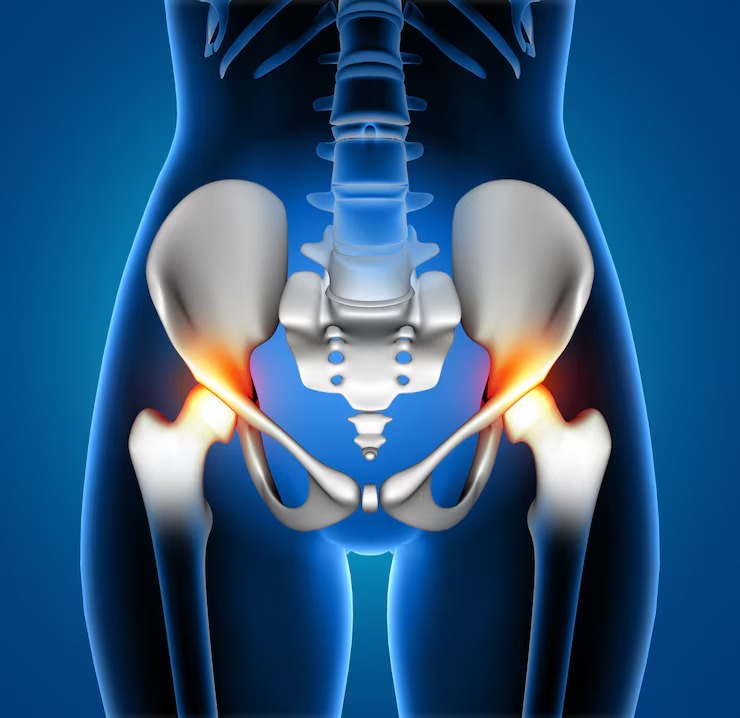
Select City
Hip replacement surgery offers a solution to persistent hip joint pain. During the hip replacement procedure, a doctor replaces your painful hip joint with an artificial implant, providing you with relief from the discomfort caused by conditions such as osteoarthritis or rheumatoid arthritis. At Pristyn Care, our dedicated team of orthopaedic doctors is well-versed in executing various types of hip replacement surgeries with commendable precision and success rates.
Hip replacement surgery offers a solution to persistent hip joint pain. During the ... Read More




Free Consultation

Free Cab Facility

No-Cost EMI

Support in Insurance Claim

1-day Hospitalization

USFDA-Approved Procedure
Choose Your City
It help us to find the best doctors near you.
Bangalore
Chennai
Delhi
Gwalior
Hyderabad
Indore
Jaipur
Kochi
Mumbai
Pune
Delhi
Hyderabad
Pune
Mumbai
Bangalore
Partial Hip Replacement, also known as hemiarthroplasty, involves replacing only the femoral head while keeping the natural hip socket intact. Surgeons carry out this procedure when the femoral head is damaged, but the acetabulum is still healthy and works well. This method is different from total hip replacement, which replaces both the femoral head and the acetabulum.
The major differences between Partial Hip Replacement and total hip replacement are:
| Aspect | Partial Hip Replacement | Total Hip Replacement |
| Bone Preservation | Maintains the natural hip socket, preserving more bone structure | Replaces both femoral head and socket, removing more native bone |
| Surgical Complexity | Requires less surgical time and fewer bone cuts | Involves more extensive bone removal and longer surgery duration |
| Recovery Period | Typically shorter hospital stay and faster early recovery | Recovery may take longer due to greater surgical intervention |
| Implant Components | Only the femoral head is replaced | Both the femoral head and the acetabulum are replaced |
| Future Options | Allows for future conversion to total replacement if needed | No further conversion options; revision surgery may be more complex |
• Disease name
Osteoarthritis
• Surgery name
Partial hip replacement surgery
• Duration
1 to 3 hours
• Treated by
Orthopedic surgeon

Fill details to get actual cost
The hip joint is one of the body’s largest ball-and-socket joints, connecting the thigh bone to the pelvis. This complex structure supports body weight during standing, walking, and running activities.

The hip joint consists of three main components that work together:
The hip joint performs essential functions that enable daily activities. Weight-bearing capacity allows the joint to support the entire body during standing and walking. The range of motion permits forward, backward, and sideways leg movement plus rotation.
Hip problems develop when these structures become damaged or deteriorated:
There are two main types of hemiarthroplasty based on the implant design.
Patient selection for partial hip replacement requires careful evaluation of clinical factors to ensure successful outcomes. Clear indications and contraindications aid surgical decisions and promote patient safety.
Hip fractures in elderly patients represent the primary indication for Partial Hip Replacement treatment. These fractures occur in the femoral neck area, where bone density is lower and healing potential is limited. Specific fracture patterns that benefit from this procedure include:
Additional medical conditions that might require a partial hip replacement include avascular necrosis and certain bone tumors. Avascular necrosis of the femoral head occurs when the blood supply is cut off, leading to damage and the collapse of the bone. Some bone tumors affecting the femoral head may also need the damaged area taken out and replaced with prosthetic parts.
Diet & Lifestyle Consultation
Post-Surgery Follow-Up
Free Cab Facility

24*7 Patient Support
Several factors make patients unsuitable candidates for this procedure:
Hip problems that require surgical intervention often show distinct symptoms that gradually worsen over time. What may begin as mild discomfort during physical activity can progress to persistent pain, eventually occurring even at rest.
The signs and symptoms that lead to the need for Partial Hip Replacement are:
The diagnostic process combines clinical examination with imaging studies to confirm the need for surgery. Doctors perform physical tests to assess pain levels, range of motion, and leg length differences.
Preparation helps make sure patients are medically stable and know what the procedure involves. Medical teams carry out evaluations to find and address any possible issues before surgery.
The pre-operative steps include:
The surgery lasts 1 to 2 hours. The exact time depends on how complex the fracture is and on factors related to the patient. Surgeons make an incision over the hip joint to carefully expose the femoral head and neck area.
Immediate post-operative care focuses on pain management and preventing complications during the hospital stay. Patients remain in recovery rooms for monitoring before transfer to regular hospital rooms.
Rehabilitation and recovery progress through distinct phases with specific goals and timelines. Physical therapy starts in the hospital and continues through outpatient programs for several months.
| Timeline | What Happens |
| Day 0–2 | Hospital stay; start walking with assistance; pain relief and physiotherapy begin |
| Days 3–14 | Go home; need support; stitches removed; swelling and pain begin to ease |
| Weeks 2–6 | Resume light chores and self-care; continue physical therapy |
| Weeks 6–8 | May return to work and resume sex; feel more stable and mobile |
| 3 Months | Resume regular activities; consider low-impact sports with doctor’s approval |
| 3–6 Months+ | Continued strength and mobility improvements; long-term outlook assessed |
The cost of a partial hip replacement in India varies based on several factors. These include the type of hospital, the city, the surgeon’s experience, and the quality of the implant. The total cost may cover the hospital stay, surgery fees, implant expenses, and basic post-operative care. However, physiotherapy and diagnostic services usually come with separate charges.
| City | Estimated Cost Range |
| Delhi | ₹2,80,000 – ₹3,20,000 |
| Mumbai | ₹2,80,000 – ₹3,20,000 |
| Bengaluru | ₹2,80,000 – ₹3,20,000 |
| Chennai | ₹2,80,000 – ₹3,20,000 |
| Hyderabad | ₹2,80,000 – ₹3,20,000 |
| Kolkata | ₹2,80,000 – ₹3,20,000 |
Note: Prices are indicative and may vary by location and insurance coverage
Partial hip replacement has a reported success rate of up to 99% in India, based on data from high-volume surgical centres. However, all surgical procedures carries some risks, and this procedure includes both general surgical risks and procedure-specific complications. Awareness of these risks supports clinical decision-making regarding the procedure and postoperative care.
These complications are uncommon and treatable. Most patients recover well with regular follow-up and guided rehabilitation.
Successful long-term outcomes require patients to adapt their lifestyle and follow medical recommendations. Most patients return to normal daily activities while avoiding high-impact or high-risk movements.
Partial Hip Replacement treatment provides an effective solution for patients with femoral head damage while preserving healthy bone tissue. The procedure provides excellent pain relief and functional improvement for appropriate candidates, particularly elderly patients with hip fractures. Partial Hip Replacement helps patients make informed decisions about their treatment options. Regular follow-up care and adherence to activity guidelines ensure optimal long-term outcomes and quality of life.
If you’re considering treatment options for hip injuries or fractures, speaking with an orthopaedic specialist through Pristyn Care can help you understand what may work best for your condition.
Most patients begin walking with assistance, such as a walker, within 24 to 48 hours after surgery. Full weight-bearing is usually possible in 6 to 8 weeks, depending on the success of the Partial Hip Replacement treatment and bone healing. Complete recovery and return to routine activities may take up to 3 to 6 months.
Partial Hip Replacement is designed to be a permanent treatment for certain types of hip fractures. However, around 5% of patients may require a revision to total hip replacement within 20 years due to socket wear or other complications. Longevity depends on activity level, implant material, and overall joint health.
Spinal anesthesia is most commonly used for Partial Hip Replacement as it offers better post-operative pain control. General anesthesia may be considered based on the patient’s medical profile or preferences. Regional nerve blocks are often added to reduce discomfort during early recovery.
Yes, patients should avoid bending their hips too much, crossing their legs, or turning the operated leg inward. These limitations usually last for 6 to 8 weeks after a partial hip replacement to aid healing. The physiotherapy team will help patients move safely during this time.
Most patients stay in the hospital for 2 to 4 days after a partial hip replacement. Discharge depends on pain management, the ability to walk with assistive devices, and the absence of complications. Some patients may go to short-term rehab before returning home.
Yes, most insurance providers in India cover partial hip replacement if it is medically necessary. The coverage varies by insurer, policy, and hospital network. It’s important to check these details beforehand to avoid issues later.
Partial hip replacement is generally for older patients with limited mobility and specific types of fractures. Younger individuals are usually advised to get a total hip replacement because they are more active and the implants last longer. Exceptions are rare and evaluated on a case-by-case basis.
Physiotherapy after partial hip replacement focuses on rebuilding strength, balance, and normal walking patterns. It starts with gentle exercises and gradually moves to functional training over 6 to 12 weeks. The plan is tailored to the patient’s age, overall health, and mobility goals.
Partial hip replacement implants are made from biocompatible metals like titanium or stainless steel, often combined with ceramic or metal femoral heads. These materials ensure strength, durability, and a lower chance of rejection. Advances in implant technology have improved their performance and lifespan.
Swelling around the hip, thigh, or ankle is common and may last for several weeks. Elevating the area, using cold packs, and wearing compression garments can help manage it. If swelling persists or is painful, it may indicate a complication and should be checked by a doctor.
 Medically reviewed by:
Medically reviewed by: